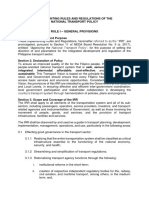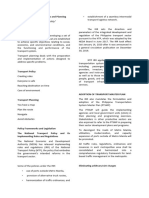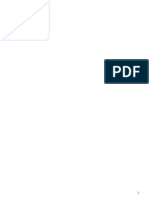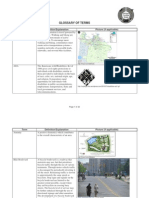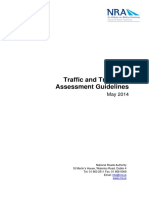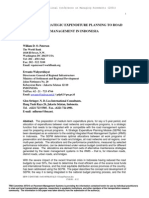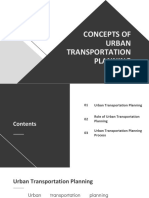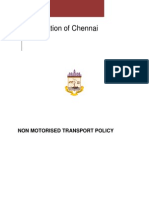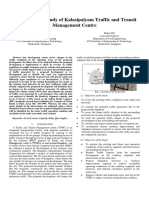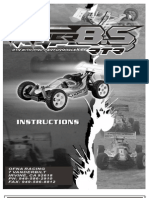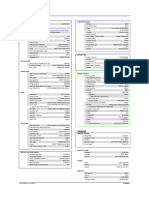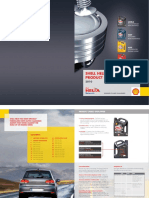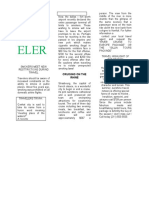Iword Mo To
Iword Mo To
Uploaded by
kristin.luceroCopyright:
Available Formats
Iword Mo To
Iword Mo To
Uploaded by
kristin.luceroOriginal Title
Copyright
Available Formats
Share this document
Did you find this document useful?
Is this content inappropriate?
Copyright:
Available Formats
Iword Mo To
Iword Mo To
Uploaded by
kristin.luceroCopyright:
Available Formats
June 19, 2017
DOTr DEPARTMENT ORDER NO. 011-17
SUBJECT : Omnibus Guidelines on the Planning and Identification of
Public Road Transportation Services and Franchise Issuance
WHEREAS, Executive Order 125-A and Executive Order 202, s. 1987, n
consistent with the national government policy, authorize and promote
adequate, safe, reliable, efficient, and environment-friendly Public Utility
Vehicles (PUVs);
WHEREAS, public road transport services nationwide should be
provided in a timely, sufficient, cost-effective, and reliable manner;
WHEREAS, the Department recognizes the need to depart from the
long-standing exclusive reliance on private sector initiative in serving local
road transport requirements that are processed by the Land Transportation
Franchising and Regulatory Board (LTFRB) without the benefit of local public
transport plans based on local mobility requirements;
WHEREAS, it is the Department's policy that a local-level public
transport planning approach, in line with the decentralization envisioned by
Republic Act (R.A.) 7160 or The Local Government Code of the Philippines
(LGC), will, in the longer term, be more effective in determining local public
transport services;
WHEREAS, Section 17 of the LGC further provides that LGUs,
particularly in cities, shall endeavor to provide adequate, effective, and
efficient transportation facilities that would provide access and mobility for
its people to pursue socio-economic activities, as reflected in its
Comprehensive Land Use Plan (CLUP);
WHEREAS, the Department recognizes the subsidiarity principle that
LGUs are in a better position to identify local public transport service
requirements and formulate plans for improving connectivity between and
among their urban and rural socio-economic activities, in the province and
the region that they are a part of;
NOW THEREFORE, I, ARTHUR P. TUGADE, Secretary of the
Department of Transportation, by virtue of the powers vested in me by law,
hereby order that the following rules and procedures on the issuance of
franchises for public transport routes and services be hereby adopted:
1. DEFINITION OF TERMS
1.1 Alternative Fuel Vehicles/Engines — vehicles/engines that
use alternative fuels such as biodiesel, bioethanol, natural gas, electricity,
solar, hydrogen, and automotive LPG, instead of gasoline and diesel.
1.2 Arterial Roads — roads that provide the highest level of
service for the longest uninterrupted distance, with some degree of access
CD Technologies Asia, Inc. © 2022 cdasiaonline.com
control. They may be highways and be circumferential or radial in form.
These roads deliver traffic from collector roads to other arterial roads and
expressways.
1.3 Certificate of Public Convenience (CPC) — permit issued by
the LTFRB for the operation of road transportation services for public use.
1.4 Collector Roads — roads that provide a less highly developed
level of service at a lower speed for shorter distances. Their function is to
collect traffic from local roads and connect them to arterial roads.
1.5 Comprehensive Development Plan (CDP) — the action plan
prepared by a local government to develop and implement priority
sectoral and cross-sectoral programs and projects in the proper locations
gradually and incrementally, until the desired shape or form of
development is eventually attained.
1.6 Comprehensive Land Use Plan (CLUP) — the plan for long
term management of the local territory, identifying areas where
development can and cannot be located and directing public and private
investments accordingly.
1.7 Comprehensive Local Transport Plan (CLTP) — a detailed
plan addressing the mobility needs of both people and freight, describing
policies and programs for the operation, management, improvement,
maintenance, and best use of resources for the delivery of high quality
transport services.
1.8 DENR — the Department of Environment and Natural
Resources.
1.9 Department — the Department of Transportation.
1.10 Developmental Routes — routes designed to serve new
residential, commercial, and other land use developments.
1.11 Expressways — highways with limited access, normally with
interchanges; may include facilities for levying tolls for passage in an open
or closed system.
1.12 Garage — an off-street area where public utility vehicles are
stored or parked while not in operation and where repair or maintenance
works are done.
1.13 Hop-on Hop-off — a type of tourist transport service that
stops to load and unload passengers, and which caters to a network of
tourist destinations.
1.14 Land Transportation Franchising and Regulatory Board
(LTFRB) — the Board composed of the Chairman and two (2)
commissioners, created by virtue of Executive Order (E.O.) 202, series
1987 under the Department.
1.15 Local Government Units (LGUs) — city, provincial, and
municipal governments, or agencies or authorities responsible for special
economic zones or administrative regions.
CD Technologies Asia, Inc. © 2022 cdasiaonline.com
1.16 Local Public Transport Route Plan (LPTRP) — a plan
detailing the route network, mode, and required number of units per mode
for delivering public land transport services. This is prepared by Local
Government Units and approved by the Department/LTFRB. This plan shall
serve as the basis of a comprehensive local transport plan.
1.17 Local Roads — roads not defined as arterial or collector. They
primarily provide access to land with little or no through movement.
1.18 Loop service — a continuous service with a specific route
structure within a defined zone which includes, but is not limited to,
industrial parks, economic zones, school campuses, and emerging business
districts. These routes shall start and terminate at an off-street terminal.
1.19 Metro Manila Urban Transport Integration Study
Update and Capacity Enhancement Program (MUCEP) Study Area —
area consisting of the sixteen (16) cities (Caloocan, Las Piñas, Makati,
Malabon, Mandaluyong, Manila, Marikina, Muntinlupa, Navotas, Pasay,
Pasig, Parañaque, Quezon City, San Juan, Taguig, and Valenzuela) and
one (1) municipality (Pateros) of Metro Manila and identified cities and
municipalities in its adjoining provinces (Bulacan, Rizal, Laguna, and Cavite)
that constitute the geographical coverage of the MUCEP research.
1.20 Operator — a holder or grantee of a valid and subsisting CPC
issued by the LTFRB.
1.21 Point-to-Point (P2P) Bus Services/Express Buses — bus
services using mini-coaches or coaches providing direct services from origin
to destination without boarding or alighting passengers in between.
1.22 Public Transport Planning — the professional discipline
responsible for developing public transport systems. It is a hybrid discipline
involving aspects of geography, social sciences, transport engineering, and
urban planning.
1.23 Public Utility Buses (PUBs) — air-conditioned and/or non-
air-conditioned coaches used as Public Utility Vehicles and classified as
mass transit system, further classified in Section 2.2.
1.24 Public Utility Jeepneys (PUJs) — Public Utility Vehicles that
are used as feeder services to mass transit systems such as buses, BRT and
rail transport, and further classified in Section 2.2.
1.25 Public Utility Vehicles (PUVs) — vehicles that carry
passengers and/or cargo for a fee, offering services to the public, which may
include, but are not limited to, UV Express Service, PUBs, PUJs, TNVS, Filcab
and Taxis. Further classifications are provided in Section 2.2.
1.26 Refurbished or Rebuilt Vehicles — used and/or pre-
registered vehicles with used/new/remanufactured chassis and
engine/motor, with upgraded body designs, braking systems, and/or safety
devices meeting public safety and emission standards.
1.27 Route — a path with defined starting and ending points that a
public transportation unit is authorized to operate, as defined in the unit's
CD Technologies Asia, Inc. © 2022 cdasiaonline.com
CPC.
1.28 Safety Officer — a person tasked to ensure the suitability of
vehicles in operation whose responsibilities include, but are not limited to,
the regular monitoring of a vehicle's safety features, assessing a driver's
fitness and capability to drive, and conducting safety trainings.
1.29 School Services — Public Utility Vehicles providing services
to students and school officials from school vicinities to residences and vice-
versa, and issued authority on the basis of a valid contract with, or
authorization from, a school, and further classified in Section 2.2.
1.30 Stops — are strategically located points or areas within an
authorized route that are officially designated and allocated for pick-up and
drop-off of passengers.
1.31 Terminal — off-street area where passengers board and
alight, usually located at the start and at the end of a route.
1.32 Transfer Area — an area, hub, or facility where two (2) or
more routes meet, enabling passengers to connect or transfer to other
routes or modes.
1.33 Transport Network Corporation (TNC) — an organization
whether a corporation, partnership, or sole proprietor that provides pre-
arranged transportation services for compensation using an internet-based
technology application or digital platform technology to connect
passengers with drivers using their personal vehicles.
1.34 Transport Network Vehicle Service (TNVS) — a Public
Utility Vehicle accredited with a Transport Network Corporation (TNC), which
is granted authority or franchise by the LTFRB to run a public transport
service.
1.35 Transport Planning — the process of defining future policies,
goals, investments, services, facilities, and designs to prepare for the
expected mobility requirements of people and/or goods.
1.36 Turning Point — route ends, zone centroids, road network or
turn back systems (except for loop-type services) where Public Utility
Vehicles are allowed to maneuver to resume operation and where transfer
services are normally available.
1.37 Utility Vehicle (UV) Express Service — a form of
paratransit system which uses airconditioned utility vehicles or vans that
ferry passengers directly from an authorized origin and destination. They
may pick-up (load) and/or drop-off (unload) their passengers within two (2)
kilometer radius from their end points specified in their CPCs or within the
territorial bounds of the commercial/business district specified therein.
1.38 Zoning Map — the duly authenticated map defining divisions
of different planned land uses and regulations of land into zones in a
city/municipality. It is a graphical translation of the regulations to efficiently
carry-out the presumptions of the Zoning Ordinance. For purposes of
accountability, the zoning map shall be provided with transparent overlay(s)
CD Technologies Asia, Inc. © 2022 cdasiaonline.com
depicting critical information that the users/public should know, e.g., fault
lines, subsidence areas, protected areas, and others.
1.39 Zoning Ordinance — written regulation and law that define
how property in specific geographic zones can be used. The Zoning
Ordinance is a legally binding set of rules and regulations affirming the
usage of land in a city/municipality.
2. POLICIES AND PRINCIPLES
These guidelines shall be anchored on the following Public Road
Transportation Basic Policies and Principles:
2.1 Basic Policy
The Department shall reduce reliance on private vehicle use and move
toward environmentally-sound mobility solutions, and shall develop and
promote high quality public transportation systems, including non-motorized
transport, and ensure to prioritize the movement of people and goods, rather
than vehicles. Pursuant to this, the Department shall promulgate,
administer, enforce, and monitor compliance of public land transportation
policies, laws, and regulations which promote mobility as a basic human
need.
The LTFRB is tasked to implement this Department Order and to
encourage and require the consolidation of operators and the establishment
of bigger coordinated fleets of PUVs. Incentives and higher priority may be
granted to operators with larger fleet sizes using higher capacity vehicles.
As a basic policy, PUV drivers shall undergo the mandatory continuing
drivers' education thru the Drivers' Academy and be on fixed salary and
benefits with no compensation linked to ridership.
Road public transport throughout the country shall be delivered in a
manner which is reliable, safe, accessible, environmentally friendly,
dependable, efficient, comfortable, and governed by the following principles:
2.1.1 Reliability. Public transport must be predictable in terms of
travel time, waiting time, and schedule. Commuters will benefit
from a fixed dispatch time and short intervals between vehicles
during peak demand periods, as they need not wait long for the
PUV to arrive. Operating hours for a route shall also be
responsive to the needs of visitors, night students, and workers
who require late night travel.
2.1.2 Safety. All vehicles and services shall comply with national
standards and international vehicle safety conventions. All
relevant vehicle parts shall be compliant with Philippine National
Standards (PNS). Boarding or alighting from PUVs in
undesignated stops is fundamentally unsafe. Bus stops and
stations shall be adequately lit at night for security. AH PUVs
must be equipped with fire extinguishers. Speed Limiters shall be
installed pursuant to R.A. 10916 or the Road Speed Limiter Act of
2016 and its IRR. For selected PUVs, CCTVs shall be installed to
CD Technologies Asia, Inc. © 2022 cdasiaonline.com
monitor activity in and around the vehicle, and deter traffic
violations and criminal activities. Global Navigation Satellite
System (GNSS) (e.g., GPS) receivers shall be installed on PUVs to
enable recording of vehicle location and speed and sharing of
real-time PUV information for the convenience of commuters and
operators. For all PUVs, windshield and windows shall not be
tinted.
2.1.3 Accessibility. Public transport must be available in every
community, with accessibility for all segments of society,
including senior citizens and persons with disabilities. Access
shall include good walkways and bikeways to provide connectivity
with other modes of transportation. Designated location of stops,
pick-up, and drop-off points with adequate facilities shall be
provided to facilitate convenient boarding and alighting of
passengers.
2.1.4 Environmental soundness. Public transport vehicles with
combustion engines must have low emissions, as proven by
compliance with EURO IV emission standards or better ( e.g.,
EURO V, EURO VI), as prescribed by the DENR. Other preferred
public transport vehicles are those using electric drives and/or
running on alternative fuels, such as electric and solar.
2.1.5 Comfort. The vehicle is fitted with comfortable seats where
passengers are able to relax, rest, and be productive during the
journey, through the provision of Wi-Fi access. For buses that
permit standing passengers, the number of standing passengers
must not exceed five (5) persons per square meter of the
available standing space.
To achieve the above principles, the LTFRB shall provide guidelines on
key performance indicators that set the quality of service for all land
public transport operations.
2.2 Hierarchy and Classification of Public Transportation
Modes
As a matter of policy, the modes of transportation shall follow the
hierarchy of roads. Thus, higher capacity transportation modes shall have
priority in terms of CPC allocation and transit right of way in trunk lines or
main thoroughfares over lower capacity modes. Taxis, TNVS, tourist
transport services, and shuttle services are excluded as they are considered
as door-to-door services and do not have specific routes. Thus, as a general
rule, assigning higher capacity modes to routes currently traversed by lower
capacity modes in the Local Public Transport Route Plan may be allowed, but
not otherwise.
The operation of tricycles shall be in accordance with Joint
Memorandum Circular No. 1, series of 2008 of the DILG and the DOTC, which
states that tricycle operation should only be confined along city or municipal
roads, not along national roads and is limited only to routes not traversed by
higher modes of public transport. Motorcycles and other farm implements
CD Technologies Asia, Inc. © 2022 cdasiaonline.com
such as the kuliglig are likewise not allowed as public transport conveyance.
Further basis of the provision of this mode should also be the LPTRP.
Modes and routes shall be classified and prioritized as follows:
2.2.1 Public Utility Buses (PUBs)
Route : Buses operate along arterial roads, highways, expressways, and
identified collector roads.
Services : Regular (non-airconditioned), Airconditioned, Express, Point-to-
Point (P2P), Shuttle, Loop, Premium, and Limited Stop.
Fare Collection : Based on distance or zonal as authorized by the LTFRB.
Body Make : Coach with entry and exit doors; emergency exits; tempered glass
windows; minimum eleven (11) meters in length; single-deck,
articulated or double-deck; city buses should be low entry for
quick boarding and alighting and with space for at least one (1)
passenger with wheelchair and foldable or retractable wheelchair
ramp at curbside door.
Provincial buses shall use coaches with at least eleven (11)
meters in length with provisions for cargo compartments.
Seating arrangements, except for provincial buses, may be along
the length of the bus, along the width of the bus, or a combination
thereof. Reclining seats may be allowed for tourist and premium
bus services.
The above Body Make shall be subject to further specifications as
provided by the LTFRB.
Other Features : With GNSS receiver, free Wi-Fi, CCTV (4 cameras, continuous
recording of past 72 hours of operation), Automatic Fare Collection
System (AFCS) for PUBs within highly urbanized independent
cities, speed limiter, and dashboard camera (at least 24 hours of
recording) compliant with LTFRB specifications; compliant with
prescribed DENR emissions standards or better; with lay-
over/garage with sufficient space for all units, plus additional
space of at least 30% of the total PUV space requirement.
Year Model : Year models of the chassis and the engine or motor shall be
current as of franchise application.
2.2.2 Mini-buses
Demand : It shall serve routes with passenger demand up to a maximum
of 5,000 pphpd.
Route : Mini-buses operate along major arterial roads, highways,
expressways, and identified collector roads.
Mini-buses are appropriate for corridors where demand may be
insufficient for operation of larger-sized buses.
Service : Regular (non-airconditioned), Airconditioned, Loop, Shuttle, and/or
Express.
CD Technologies Asia, Inc. © 2022 cdasiaonline.com
Fare Collection : Based on distance and/or zonal as authorized by the LTFRB.
Body Make : Mini coach with emergency exit, tempered glass windows, seven
(7) to nine (9) meters in length, single-deck; with no wooden
components; for urban routes, should be low entry for quick
boarding and alighting and with space for at least one (1)
passenger with wheelchair and foldable or retractable wheelchair
ramp at curbside door.
The above Body Make shall be subject to further specifications as
provided by the LTFRB.
Other Features : With GNSS receiver, free Wi-Fi, CCTV (4 cameras, continuous
recording of past 72 hours of operation), Automatic Fare Collection
System (AFCS) for Mini-buses within highly urbanized independent
cities, speed limiter, and dashboard camera (at least 24 hours of
recording) compliant with LTFRB specifications; compliant with
prescribed DENR emission standards or better; with lay-
over/garage with sufficient space for all units, plus additional
space of at least 30% of the total PUV space requirement.
Year Model : Year models of the chassis and the engine/motor shall be current
as of franchise application.
2.2.3 Public Utility Jeepneys (PUJs) and Utility Vehicle (UV)
Express Services
Demand : It shall serve routes with passenger demand at a maximum of
1,000 pphpd.
Route : Appropriate as feeder services operating in arterial, collector, and
local roads, linking neighborhoods and communities to mass
transit lines and bus routes, and traversing commercial, industrial,
recreational, or residential area.
However, this mode is restricted from operating along EDSA and
national highways or expressways in highly urbanized areas.
Further guidance and exceptions shall be issued by the LTFRB.
Fare Collection : Based on distance and/or zonal as authorized by the LTFRB.
Body Make : Vehicle below seven (7) meters in length; door locations should
allow boarding and alighting only from the curbside, not from the
rear.
The Body Make shall be subject to further specifications as
provided by the LTFRB.
Other Features : GNSS receiver, free Wi-Fi, CCTV with continuous recording of past
72 hours of operation, Automatic Fare Collection System (AFCS)
for PUJs and UV Express Services within highly urbanized
independent cities, speed limiter, and dashboard camera (at least
24 hours of recording) compliant with LTFRB specifications;
compliant with prescribed DENR emission standards or better;
with lay-over or garage with sufficient space for all units, plus
additional space of at least 30% of the total PUV space
requirement.
CD Technologies Asia, Inc. © 2022 cdasiaonline.com
Year Model : For UV Express Services, the year models of the chassis and the
engine or motor shall be current as of franchise application.
For PUJs, guidelines shall be subject to further specifications as
provided by the LTFRB.
2.2.4 Filcab Service
Demand : It shall serve routes with maximum passenger demand of 500
pphpd. Whenever applicable, this service is meant to replace
tricycles on roads and areas where tricycle operations are
restricted (Administrative Order No. 1, s. 1968 DPWH).
Operation : Fixed routes (regular, limited stop and/or express) and intra-zonal
(i.e. zones as defined in the LGU Zoning Ordinance) within a
specified area as authorized. Operation shall be prohibited on
arterial roads, highways, and expressways.
Fare Collection : Based on distance or zonal as authorized by the LTFRB.
Body Make : Mini-Jitney/Multicab, seating capacity of seven (7) to eleven (11)
passengers excluding the driver; door locations should allow
boarding and alighting only from the curbside, not from the rear.
Other Features : GNSS receiver, Automatic Fare Collection System (AFCS) for Filcab
services within highly urbanized independent cities, speed limiter
compliant with LTFRB specifications; compliant with prescribed
DENR emission standards or better; with lay-over or garage with
sufficient space for all units, plus additional space of at least 30%
of the total PUV space requirement.
Year Model : Year models of the chassis and the engine/motor shall be current
as of franchise application.
2.2.5 School Services
Route : School to residence subject to valid contract or school
authorization.
Fare Collection : As may be authorized by the LTFRB.
Body Make : Van, Mini coach, coaster, or coach; with front-facing seating
arrangement and individual seat belts; with chevron markings and
body painted yellow; door locations should allow boarding and
alighting only from the curbside, not from the rear.
Other Features : With GNSS receiver, free Wi-Fi, CCTV (4 cameras, continuous
recording of past 72 hours of operation), speed limiter, and
dashboard camera (at least 24 hours of recording) compliant with
LTFRB specifications; compliant with prescribed DENR emission
standards or better; with lay-over or garage with sufficient space
for all units, plus additional space of at least 30% of the total PUV
space requirement.
2.2.6 Taxis
Operation : Door-to-door service.
CD Technologies Asia, Inc. © 2022 cdasiaonline.com
Fare Collection : Metered or coupon as approved by the LTFRB.
Body Make : Van, Sedan, Utility Vehicle, Sports Utility Vehicle, or other
similar vehicles.
Other Features : With GNSS receiver, free Wi-Fi, CCTV with continuous recording of
past 72 hours of operation, and dashboard camera (at least 24
hours of recording) compliant with LTFRB specifications; compliant
with prescribed DENR emission standards or better; with lay-over
or garage with sufficient space for all units, plus additional space
of at least 30% of the total PUV space requirement.
Year Model : Year models of the chassis and the engine or motor shall be
current as of franchise application.
2.2.7 Transportation Network Vehicle Services (TNVS)
Operation : Door-to-door service.
Fare Collection : Pre-arranged fare as authorized by the LTFRB.
Body Make : Van, Sedan, Utility Vehicle, Sports Utility Vehicle, or other
similar vehicles.
Seating : Not more than seven (7) passengers excluding the driver.
Other Features : With GNSS receiver, free Wi-Fi, CCTV with continuous recording of
past 72 hours of operation, and dashboard camera (at least 24
hours of recording) compliant with LTFRB specifications; compliant
with prescribed DENR emission standards or better; with lay-over
or garage with sufficient space for all units, plus additional space
of at least 30% of the total PUV space requirement).
Further directives on fare collection, regulation, and specifications of TNVS shall be
provided by the LTFRB.
2.2.8 Tourist Transport Services
Operation : Transport services for tourists and hop-on hop-off.
Fare Collection : Based on contract with oversight function by the LTFRB.
Body Make : Coach, Mini-coach, Coaster, Van or Car, and/or SUV.
Other Features : With GNSS receiver, free Wi-Fi, CCTV with continuous recording of
past 72 hours of operation, speed limiter, and dashboard camera
(at least 24 hours of recording) compliant with LTFRB
specifications; compliant with prescribed DENR emissions
standards or better; with lay-over or garage with sufficient space
for all units, plus additional space of at least 30% of the total PUV
space requirement.
Year Model : Year models of the chassis and the engine or motor shall be
current as of franchise application.
Requirements : Department of Tourism endorsement for franchise application is
required.
CD Technologies Asia, Inc. © 2022 cdasiaonline.com
2.2.9 Shuttle Service
Operation : No fixed route.
Fare Collection : Based on contract with oversight function by the LTFRB.
Body Make : Same as bus and/or mini-bus (Section 2.2.1 and 2.2.2).
Other Features : With GNSS receiver, free Wi-Fi, CCTV (4 cameras, continuous
recording of past 72 hours of operation), speed limiter, and
dashboard camera (at least 24 hours of recording) compliant with
LTFRB specifications; compliant with DENR emissions standards or
better; with lay-over or garage with sufficient space for all units,
plus additional space of at least 30% of the total PUV space
requirement.
Year Model : Year models of the chassis and the engine or motor shall be
current as of franchise application.
2.2.10 Exceptions to Rules 2.2.1 to 2.2.10 and Issuance of
Subsequent Memorandum Circulars by the LTFRB
Any exception to the rules under 2.2.1 to 2.2.10 shall be granted
expressly and in writing by the LTFRB through a formal
unanimous resolution.
Furthermore, a Memorandum Circular shall be issued by the LTFRB
to provide further specifications and details to determine the
classification, body, make, and other requirements of the vehicles
being registered, as well as the hierarchy of a vehicle class in
relation to the route concerned.
2.3 Route Connectivity Policy
For major arterial roads, highways, and expressways, PUBs and Mini
Buses are the prescribed mode for public transport. However, PUJs, Filcabs,
and UV Express Services may operate on minimal portions of the PUB
corridor for the sole purpose of providing intermodal transfers at bus stops,
so long as such purpose is indicated in the relevant LGU transportation plan.
2.4 New or Developmental Routes
New routes shall be designed such that overlaps with existing routes
do not exceed 25% of the length of any of the affected routes. Previously
authorized routes may be restructured ( i.e., merged with another previously
authorized route, or with a new route, or shortened, or split into different
routes) due to marked change in trip patterns arising from urban renewal or
urban redevelopment projects and/or resulting from traffic circulation plans
of Local Government Units.
For new or developmental routes, a minimum fleet size of fifteen (15)
units for any type of PUV for six (6) months shall be imposed, subject to
review by the LTFRB.
Subject to an express and written grant by the LTFRB through a
formal unanimous resolution, the 25% overlap limit may be waived subject
to the
CD Technologies Asia, Inc. © 2022 cdasiaonline.com
following conditions;
2.4.1 A newly developed residential or commercial area is at least
five (5) kilometers away from the origin or destination of the
traditional route;
2.4.2 The passenger demand generated or attracted by a newly
developed area is greater than what the existing route cannot
adequately or economically serve;
2.4.3 Additional and/or new sections of a road network are
developed, thereby providing shorter and faster trips; and
2.4.4 Other conditions that may be provided by the Department,
and/or by the LTFRB with the approval of the Department.
2.5 Maximum Distance Policy
PUJ Service routes shall have the following maximum distance:
Route coverage Maximum Route
Length
Highly urbanized cities, independent component 15 km
cities, and component cities
Inter-regional, inter-provincial, provincial, and 35 km
municipal
For PUJ loop services, the loop length shall be covered by similar
restrictions.
UV Express service routes shall have the following maximum distances:
Route coverage Maximum Route
Length
Highly urbanized cities, independent 35 km
component cities, and component cities
Inter-regional, inter-provincial, provincial, 35 km
and municipal routes originating or
terminating in Metro Manila
Inter-regional, inter-provincial, provincial, 60 km
and municipal routes not originating or
terminating in Metro Manila
For PUBs, no maximum distance is required.
Exceptions to this policy may be granted if an application for the same
is expressly submitted in writing together with a conduct of transport survey
or study. The LTFRB, through a formal unanimous resolution, shall grant the
exception subject to the following conditions or situations:
2.5.1 The absence of a transfer area between route ends;
CD Technologies Asia, Inc. © 2022 cdasiaonline.com
2.5.2 The absence of alternative transport services or the existing
services/supply cannot meet the passenger demand and in some
cases, the route is abandoned;
2.5.3 Most sections of the route have limited road space or width
capacities that discourage/prevent normal operations;
2.5.4 The transport demand between the applied routes is not
substantial to assure profitable operations; and
2.5.5 Other conditions that may be provided by the Department,
and/or by the LTFRB.
2.6 Criteria for Public Transportation Route Rationalization
The establishment of public transportation routes and the
corresponding modes of services shall be based on the following criteria:
2.6.1 Passenger demand patterns and characteristics;
2.6.2 Road network configuration;
2.6.3 Corresponding road functions (road hierarchy); and
2.6.4 Road capacities.
3. PROCEDURAL GUIDELINES
3.1 Local Public Transport Route Planning
The Local Public Transport Route Plan shall be the minimum
requirement prescribed for the issuance of franchises. This shall form part of
the Local Transport Plan (LTP) which relates land use to transport modes and
provides measures for traffic management.
3.1.1 The Department shall set guidelines, criteria, and procedures
for local public transport route planning and help build local
capacities to prepare LPTRPs and consequently, LTPs. The
Department shall facilitate other channels for capacity building
assistance to local governments and metropolitan authorities,
through linkages with national agencies, academe, and
development agencies.
3.1.2 Cities and municipalities shall be responsible for collecting
data, analyzing public transport supply and demand, and
identifying specific public transport supply gaps for travel within
their territories and for capturing this in city and municipal public
transportation plans.
3.1.3 Provincial governments shall be responsible for collecting
data, analyzing public transport supply and demand, and
identifying specific public transport supply gaps for travel
between component cities and municipalities within the province
and for capturing this in provincial public transportation plans.
3.1.4 Identification of public transport supply gaps and public
transportation planning between and among independent cities,
provinces, and regions not covered under 3.1.2 and 3.1.3 shall be
CD Technologies Asia, Inc. © 2022 cdasiaonline.com
the responsibility of the Department.
3.1.5 LPTRPs shall identify the additional services that are required
within the area of responsibility, including routes, the type of
service required, and the number and type of vehicles for each
service and route.
3.1.6 Transportation plans from LGUs, duly approved by the
respective Sanggunians, shall be made in accordance with the
policies stated in this Order and subsequent issuances and
guidelines from the Department. These plans must focus on the
movement of people and individual trips, not on the movement of
vehicles.
3.1.7 In the conduct of transport surveys and other data collection
for purposes of route identification, the LGUs shall encourage the
participation of concerned stakeholders.
3.1.8 City and municipal governments within the MUCEP Study Area
shall develop their local LPTRPs covering public transport services
that operate exclusively within their boundaries. However, inter-
city or inter-municipal transportation planning for the MUCEP
Study Area shall be done by the Department.
3.1.9 Emphasis shall be given to connectivity of transportation
between and among cities and municipalities considering the
volume of passengers, as well as the inter-modality of transport
services.
3.2 Approval Process for Local Public Transport Route Plans
(LPTRPs)
3.2.1 The LPTRPs covered by 3.1.2 and 3.1.3 and other
documentary requirements specified in Section 4 shall be
submitted to the LTFRB for review and approval, subject to the
oversight function of the Department.
3.2.2 The documentary requirements shall be evaluated and
approved by the LTFRB for consistency and compliance with this
Department Order and further Memorandum Circulars.
3.2.3 Once approved, the LTFRB shall conduct an open and
transparent process to select the public transport operators to
deliver the needed services.
3.2.4 In case the LGU is not ready to take on the responsibility for
public transport route planning in its domain, or if an approved
LPTRP for the city or municipality is not yet available, the
Department can determine the routes and services for which
franchises shall be issued by LTFRB.
3.2.5 The LTFRB shall develop an online database of public
transportation franchises, by region, route, and type of service.
3.3 Route Requirements
CD Technologies Asia, Inc. © 2022 cdasiaonline.com
In order to improve operations and quality of service, existing
operators are to consolidate.
3.3.1 Routes shall have a minimum number of units as set by the
LPTRPs, provided that the minimum number of units may be
increased by up to 15% to cover the downtime or maintenance of
units.
3.3.2 A route shall have the least possible number of operators, as
determined by the LTFRB.
3.3.3 Taxis, TNVS, and Tourist Transport Services shall have a
minimum of ten (10) units.
3.4 Issuance of Franchises for Public Transportation
Services
3.4.1 The LTFRB shall publish a call for applications to service the
areas with determined public need.
3.4.2 For each route or service identified for franchise issuance, the
LTFRB shall announce a selection process and invite applications
with an application deadline. The invitation shall state the route,
number of units, service quality standards, vehicle specifications,
suggested fare, and other requirements which are consistent with
the policies of this Department and other government agencies.
3.4.3 The invitation shall also state the qualification requirements
for each applicant, the documents required to be submitted to the
LTFRB, and the evaluation criteria and process to be used in
evaluating the applications.
3.4.4 The LTFRB may impose minimum fleet sizes for operators on
a route, as needed.
3.4.5 If selected, the operator concerned shall be issued a franchise
consistent with, and subject to, the rules and regulations
governing public transport franchises.
3.4.6 CPCs issued in violation of the moratorium (LTFRB
Memorandum Circulars No. 2003-028 and 2010-025) shall be
addressed in a subsequent LTFRB Memorandum Circular.
3.5 Route Modification
LGUs may propose modifications in routes for review and approval of
the LTFRB and the Department. The proposals for route modifications should
include the rationale or justification for the changes.
3.6 Road Transport Planning Division (RTPD)
The primary responsibility of promoting the preparation of LPTRPs as
described above as well as monitoring the implementation by the LTFRB of
the provisions of this D.O. shall be lodged with the Road Transport Planning
Division (RTPD) of the Department.
3.7 Mandates and Functions of the RTPD
CD Technologies Asia, Inc. © 2022 cdasiaonline.com
In addition to current functions and responsibilities of the Road
Transport Planning Division, the Division shall also have the function of
building LGU capacities to prepare the LPTRPs.
4. REQUIREMENTS
In accordance with R.A. No. 7160, the Local Government Code of 1991,
the Department of the Interior and Local Government (DILG) Memorandum
Circular No. 2011-712, Guide to Comprehensive Development Plan (CDP)
Preparation for Local Government Unit , the Housing and Land Use
Regulatory Board (HLURB) Guide to Comprehensive Land Use Plan
Preparation Volume 1 (2014) and other pertinent laws, the LGU and/or its
equivalent body shall submit to the Department a copy of the Infrastructure
Sector Study of the Comprehensive Development Plan including the
following:
4.1 Local Public Transport Route Plan
4.1.1 List and map of existing public transportation routes,
i.e., PUB, PUJ, UV Express Service, Filcab, tricycles, and other
public transport operating in the area including route descriptions
(citing specific streets and barrage name), route distances,
number of operating and authorized units, operating hours per
route, route turnaround time, estimated travel time from origin to
destination, and average frequency or headway per route per
day.
4.1.2 List and map of proposed routes indicating the route
name, route length, route alignments, transport mode, the type
of service required, the frequency of service along each route, the
number of vehicles for each route, and route structure
descriptions, citing specific street and barangay names. The
LPTRP shall also contain the specific location of stops, pick-up and
drop-off points, and from origin to destination and vice versa, as
well as terminal or turning points as defined in Section 7 hereof.
In the determination of the number of vehicles for each route, a
minimum of fifteen (15) introductory units shall be imposed for
developmental routes, which shall then be re-evaluated by the
LTFRB after six (6) months of operation upon the determination
and establishment of the actual demand for the services in the
route. The map shall also indicate the road classification and link
attributes such as distance, number of lanes per direction, and
average travel speed.
The LPTRP should be regularly evaluated and updated every five (5)
years.
4.1.3 Estimated existing and forecasted passenger demand
for each proposed route, i.e., estimated passenger volume
between identified stops along the entire stretch of the
proposed route and describing clearly the methodology and
assumptions used in the generation of estimated passenger
demand.
CD Technologies Asia, Inc. © 2022 cdasiaonline.com
4.1.4 Inventory of available transport facilities to include
information on location of transport infrastructure support
facilities, i.e., park and ride, bicycle lanes, parking terminals,
loading and unloading areas, Intelligent Transport Systems (ITS),
and other transport infrastructure, i.e., airport, ports, and
railways, as applicable.
4.2 All LPTRPs submitted by LGUs shall be consistent with the LGU's
respective plans embodied in their Comprehensive Development Plan
(CDP), Comprehensive Land Use Plan (CLUP), Zoning Ordinance and
Zoning Map.
4.3 The Department may provide capacity development assistance
to LGUs to establish their respective LPTRPs as it may deem necessary.
5. REQUIREMENTS FOR OPERATORS
5.1 Safety Requirements
5.1.1 PUV operators must fulfill safety operations requirements,
whereby a safety officer, employed or assigned on a full-time
basis, must inspect each unit and driver before dispatch and
ensure efficient operations on the ground with daily reports filed
and submitted to the LTFRB on a regular basis for monitoring.
It shall be the duty of the LTFRB to ensure that operators comply
with the safety requirements, by evaluating the submitted
maintenance ledger per unit. This shall be a mandatory
requirement for the confirmation of the unit.
5.1.2 Qualification requirements of safety officers shall be
established by the LTFRB through a subsequent Memorandum
Circular.
5.2 Modernization of Public Transport Services
To modernize existing transport services, brand new and
environmentally-friendly units shall be promoted and be given priority in the
allocation of CPCs and deployment, based on route categories.
Relative thereto, the following requirements shall be adopted;
5.2.1 Environmentally-friendly units are vehicles that use an electric
drive and/or a combustion engine that complies with Euro IV or
better emission standards as prescribed by the DENR to reduce
greenhouse gas emissions, toxic fumes, particulate matter, and
other forms of air pollution;
5.2.2 The LTFRB shall issue a Memorandum Circular to provide for a
modernization program for all PUVs, establishing the age limit of
each classification based on the year of the oldest major
component (i.e. chassis and engine/motor) of the vehicle and not
the initial year of registration or the year of importation; and
5.2.3 Refurbished and/or rebuilt vehicles shall pass the type
approval system test and issued a Certificate of Compliance with
CD Technologies Asia, Inc. © 2022 cdasiaonline.com
Emission Standards (CCES) as a condition to initial registration by
the LTO and to the roadworthiness test of the LTO-Motor Vehicle
Inspection System for renewal of registration. Refurbished and/or
rebuilt PUBs, even with new engines or motors, shall not be
allowed to substitute for phased-out units.
5.3 Off-Street Terminal
5.3.1 For fixed routes with end points, no franchise application,
petition for modification of franchise, petition for dropping and/or
substitution, petition for change of ownership and/or petition for
extension of franchise validity shall be entertained by the LTFRB
without the presentation of a proof of operation of an off-street
terminal. However, for circular routes or routes that loop, an off-
street terminal may not be required based on the determination
of the LTFRB;
5.3.2 If rented and/or leased, the off-street terminal shall have a
contract validity of at least the duration of franchise validity;
5.3.3 Off-Street terminals shall be located at both ends of the route
being proposed, and shall be provided with loading/unloading
bays and vehicle layover areas;
5.3.4 The minimum terminal size must be at least 130% of the total
space requirement of 50% of the franchised units; and
5.3.5 Private sector participation in the development of terminals
shall be encouraged.
6. ABANDONMENT OF ROUTES
6.1 Abandonment of services in a PUV fixed route shall be prohibited. A
fleet operator operating with less than its total franchised units in the
franchised route for more than three (3) months shall be considered
abandonment of route and shall be penalized by revocation of the franchise.
6.2 Any approved vacant routes or units that were found abandoned
shall be open to new franchise application subject to the provisions of this
Guideline.
7. TERMINALS AND TURNING POINTS
7.1 LGU Clearance to Operate Terminals
The requirements for public transportation terminals shall remain
enforced and adhered to in all franchise applications. All public
transportation terminals shall comply with the LGU's land use and zoning
plan. As such, the concerned LGU, in coordination with the Department and
the LTFRB, shall have the authority to designate terminal locations and issue
prior clearance to operate said terminals, consistent with the DILG-DOTr Joint
Memorandum Circular No. 01, s. of 2008.
7.2 Terminal or Turning Point Identification Guidelines
Provision of terminals shall be consistent with the DILG-DOTr Joint
Memorandum Circular No. 01, s. of 2008. For routes outside Metro Manila,
CD Technologies Asia, Inc. © 2022 cdasiaonline.com
the LGU concerned, in coordination with the Department and the LTFRB,
shall designate the terminal or turning point.
7.3 Classification of PUJ and UV Express Services
To classify PUJ and UV Express Services, the terminal or turning point
shall be the basis. PUJ and UV Express Services from inside an urban area to
within 500 m. radius of the identified terminal turning point are classified as
urban PUJ/UV Express Services.
PUJ and UV Express Services travelling from within 500 m. radius of the
identified terminal turning point towards the provinces are considered inter-
regional, interprovincial, provincial, or municipal PUJ/UV Express Service
routes.
7.4 Intermodal or Integrated Transport System (ITS)
Terminals
All provincial routes, as designated by the approved LPTRP bound for
metropolitan areas, shall have destinations only up to the integrated
transportation terminals (ITS), where available. P2P Buses which operate
within the MUCEP Area may opt not to use the ITS terminals depending on
their approved route plans. Furthermore, routes that will be affected as a
result of the introduction of ITS shall be modified according to the approved
route plan.
8. EXCEPTIONS
Any exception to the above stated rules shall require an express and
written grant of authority to be issued through a collegial and unanimous
ruling from the LTFRB granting the exception.
In the event that the LTFRB fails to secure a unanimous vote but is able
to secure a majority vote granting an exception on matters which admit of
exception to these guidelines, the Secretary of the Department shall decide
such matters.
The LTFRB may, motu proprio and/or through an evaluation of a written
Exception Application for the same, issue and/or grant exceptions to the
above mentioned rules, provided that such grant shall be pursuant to the
general policies stated in this Order.
All submissions of Exception Applications to the LTFRB shall need to be
accompanied by recommendation/s, whether favorable or not, from all the
LGUs which have jurisdiction over the areas where the proposed route/s shall
traverse.
9. CITATIONS FOR PUBLIC UTILITY VEHICLES CLASSIFICATION
AND DESIGN
The following shall be the basis in classifying all public transport
conveyances:
9.1 Department Order 97-1097 entitled "Providing Standard
Classification for all Public Transport Conveyances " as amended by
Department Order 2004-24 entitled "Amending Department Order 97-1097
CD Technologies Asia, Inc. © 2022 cdasiaonline.com
Reclassifying Tourist Transport Service ", Department Order 2015-011
Further amending Department Order 97-1097 to Promote Mobility;
9.2 Department Order 2004-52 entitled "Including Asian Utility
Vehicle (AUV)/Van Express Service as Additional Type of Public Transport
Service Further Amending Department Order 97-1097";
9.3 LTFRB Memorandum 2006-058 entitled "Modifying Department
Order 97-1997 Amending Memorandum Circular 2004-011 Reclassifying
Tourist Transport Services to Include Corporate Transport Leasing Services
as New Tourist Transport Service Sub-Classification under Rent-A-Car
Services and Lifting the Moratorium on the Acceptance of
Applications/Petitions for New Franchises";
9.4 LTFRB Memorandum Circular 2005-023 entitled " Modifying
Department Order 2004-52 Relative to the Opening of AUV/Van Express
Services as New Public Land Transport Classification and Promulgating Its
Implementing Rules and Regulations";
9.5 Pursuant to Department Order 2010-32 entitled "Harmonization
of Motor Vehicle (MV) Classification of LTO and LTFRB"; and
9.6 Applicable Philippine National Standards (PNS);
Any vehicle design deviating from such standards shall be subject to
technical evaluation and clearance by the Department and the LTO before
the LTFRB can consider the same fit for franchise application.
10. MONITORING AND EVALUATION
Operators shall provide annual progress reports on their operations
within the 1st quarter of the succeeding year, to the LTFRB for evaluation.
These reports shall contain, among others, ridership, service quality
evaluation, financial statements, and maintenance ledgers of all vehicles.
The LTFRB shall then submit a compiled annual report to the Department by
the 2nd quarter of the succeeding year, which contains assessments and
evaluations of the reports from the LGUs.
11. TRANSITORY PROVISION
11.1 Upon effectivity, the provisions of this Department Order shall
immediately apply to all new applications for franchise and petitions for
modification.
11.2 All existing, updated, and valid franchises shall remain
effective for a maximum of three (3) years from the effectivity of this Order,
or upon the approval of new application/s for the specific route determined
by LPTRPs, whichever is earlier. For this purpose, the LTFRB will provide the
mechanism for transitioning existing and new franchisees such that the
transition under this Department Order will be completed within the
specified three (3)-year period.
11.3 The immediately preceding rule shall be applicable to petitions
for dropping or substitution.
11.4 During the three (3) year transitory period, operators that
CD Technologies Asia, Inc. © 2022 cdasiaonline.com
follow the provisions of this Department Order and subsequent
Memorandum Circulars to be issued by the LTFRB shall have an extended
franchise duration, with terms and conditions to be specified by the LTFRB.
11.5 During the transitory period, the LTFRB shall adopt a policy
whereby franchise applications will undergo a two-step process. On the first
stage, the citizenship requirement and financial capability as well as proof of
public need shall be submitted, except for the unit or vehicle proposed to be
authorized. On the second stage, the operator will be given a period by the
LTFRB to procure their vehicle(s). Operators with smaller fleets shall have an
earlier deadline than those with large fleets. Once the vehicle is presented
and approved, then the franchise is granted.
11.6 During the transitory period, operators that do not follow fleet
requirements as detailed in Section 3.3 shall be permitted, provided that the
same shall integrate operations management, including dispatching, an off-
street terminal, and safety inspections, with other operators such that the
fleet organized under the common operations management shall satisfy the
provisions in Section 3.3.
11.7 Measures to mitigate any adverse social impact on the
vulnerable members of the public transport sector in the implementation of
this Order may be adopted by the Department, in consultation with the
LTFRB and, when necessary, with the affected stakeholders.
11.8 Sections 11.1 to 11.7 notwithstanding, the Department and the
LTFRB shall impose such additional terms, restrictions, or limitations as may
be deemed necessary to implement the policies and purposes of this Order.
12. SEPARABILITY CLAUSE
If any part or provision of this Department Order is held
unconstitutional or invalid, other parts of provisions which are not affected
shall continue to remain in full force and effect.
13. REPEALING CLAUSE
All other Department Orders, Circulars, Special Orders, Office Orders
and/or other issuances inconsistent herewith are hereby superseded or
modified accordingly.
14. EFFECTIVITY
This Department Order shall take effect thirty (30) days following
completion of its publication in the Official Gazette and/or in a newspaper of
general circulation and/or the filing of three (3) copies hereof with the UP
Law Center pursuant to Memorandum Circular 11 dated 09 October 1992 of
the Office of the President.
(SGD.) ARTHUR P. TUGADE
Secretary
n Note from the Publisher: Written as "Administrative Order 202" in the original
document.
CD Technologies Asia, Inc. © 2022 cdasiaonline.com
You might also like
- Transportation Engineering TermsDocument2 pagesTransportation Engineering TermsEmmanuel Sto Tomas100% (1)
- The Pillars of TrafficDocument36 pagesThe Pillars of TrafficMichelle Maika Pal100% (3)
- Cagayan de OroDocument74 pagesCagayan de OroKimiko SyNo ratings yet
- DPWH Procedure ManualDocument182 pagesDPWH Procedure ManualrubydelacruzNo ratings yet
- Sis CaterpillarDocument19 pagesSis Caterpillarrutasudsoft60% (10)
- TIPD Qatar Traffic Manual & GuidelinesDocument197 pagesTIPD Qatar Traffic Manual & GuidelinesKevinSam50% (4)
- OFGnewDocument22 pagesOFGnewHyacenth BendañaNo ratings yet
- LPTRP SummaryDocument2 pagesLPTRP Summarykeren blancoNo ratings yet
- Civil Services Commission Memo-14 s-2020Document10 pagesCivil Services Commission Memo-14 s-2020Kit Delgado CameñaNo ratings yet
- Principles of Transportation Engineering PrelimDocument7 pagesPrinciples of Transportation Engineering PrelimRalph Denver RomanoNo ratings yet
- LPTRPM - Module 0 - PUVMP Presentation For The LGU CapBuild - 25 March VersionDocument84 pagesLPTRPM - Module 0 - PUVMP Presentation For The LGU CapBuild - 25 March VersionRichard MendezNo ratings yet
- An Ordinance Providing For The Adoption of The New Traffic Management Code of Caloocan CityDocument54 pagesAn Ordinance Providing For The Adoption of The New Traffic Management Code of Caloocan CityJenniferValle100% (2)
- TransportDocument9 pagesTransportannaicamalhotraNo ratings yet
- Service Contracting Mechanics - DraftDocument20 pagesService Contracting Mechanics - DraftLyn AvestruzNo ratings yet
- Highway and Railroad Engineering: Assignment #1 QuestionsDocument4 pagesHighway and Railroad Engineering: Assignment #1 QuestionskyliegNo ratings yet
- Transport Planning - CENG 6303Document23 pagesTransport Planning - CENG 6303yosematheNo ratings yet
- 2transportation Planning and EngineeringDocument10 pages2transportation Planning and EngineeringprabinNo ratings yet
- NTP Irr - SignedDocument24 pagesNTP Irr - SignedPalanas A. VinceNo ratings yet
- Transpo NotesDocument20 pagesTranspo NotesGrace TablizoNo ratings yet
- Philippine Transportation System Transpo Group 1Document8 pagesPhilippine Transportation System Transpo Group 1KNo ratings yet
- Development of Urban Transport System in JordanDocument17 pagesDevelopment of Urban Transport System in Jordanmohammed ahmedNo ratings yet
- Nternal Transport FacilitesDocument86 pagesNternal Transport FacilitesAlaa DouwidarNo ratings yet
- 4.05.2021 Tricycle-Lanes Rev. 2Document11 pages4.05.2021 Tricycle-Lanes Rev. 2Jose Edward DavilaNo ratings yet
- International Refereed Journal of Engineering and Science (IRJES)Document6 pagesInternational Refereed Journal of Engineering and Science (IRJES)www.irjes.comNo ratings yet
- Local Public Transport Plan (APPROVED COPY)Document35 pagesLocal Public Transport Plan (APPROVED COPY)Sir PlannerNo ratings yet
- Joint Memo Circular No.001Document7 pagesJoint Memo Circular No.001Ansis Villalon PornillosNo ratings yet
- Transportation MPD 2021Document12 pagesTransportation MPD 2021Shashikant Nishant SharmaNo ratings yet
- CE122-2 - A3: Traffic and Highway EngineeringDocument13 pagesCE122-2 - A3: Traffic and Highway EngineeringTDRO BATANGASNo ratings yet
- Traffic Module 4Document11 pagesTraffic Module 4Rey Niño AbucayNo ratings yet
- Chapter 1Document48 pagesChapter 1hdhena01No ratings yet
- Complete Streets Glossary of TermsDocument22 pagesComplete Streets Glossary of TermsLeague of Michigan BicyclistsNo ratings yet
- CENG95 Lecture 03 Urban Transportation PlanningDocument7 pagesCENG95 Lecture 03 Urban Transportation PlanningMark LaurenceNo ratings yet
- Republic of The Philippines Public Transit Institutional Study - Sweco - 20181116Document50 pagesRepublic of The Philippines Public Transit Institutional Study - Sweco - 20181116Daniel K. Bayona IIINo ratings yet
- Chapter 1Document35 pagesChapter 1Tamil MoviesNo ratings yet
- Public TransportDocument7 pagesPublic TransportDENNIS IBUINo ratings yet
- (Annex A) - Revised Draft Amendments To The EnTSUPERneur Program Implementing GuidelinesDocument27 pages(Annex A) - Revised Draft Amendments To The EnTSUPERneur Program Implementing GuidelinesjamaicaNo ratings yet
- TDC-15-S-1 Introduction To Driving R.A. No. 4136Document13 pagesTDC-15-S-1 Introduction To Driving R.A. No. 4136Santy UyNo ratings yet
- Lecture 2 - Transportation As A System and The Philippine Transportation SystemDocument9 pagesLecture 2 - Transportation As A System and The Philippine Transportation Systemxjm2cxzgv2No ratings yet
- TIA Guidelines Ireland PDFDocument21 pagesTIA Guidelines Ireland PDFTahmidSaanidNo ratings yet
- Résumé Exécutif - Projet BRT Dakar - Janv - 2017Document24 pagesRésumé Exécutif - Projet BRT Dakar - Janv - 2017CHEIKH ALRAZAKH SALLNo ratings yet
- CE 4251 Transportation Engineering-III Lecture: 2 HRS/ Week Credit: 2.00 Prereq. CE 351Document61 pagesCE 4251 Transportation Engineering-III Lecture: 2 HRS/ Week Credit: 2.00 Prereq. CE 351jahid shohagNo ratings yet
- MASTER_SPECIFICATION_-_PART_RD-PT-D1_-_BUS_OPERATIONAL_GUIDELINES.DOCXDocument17 pagesMASTER_SPECIFICATION_-_PART_RD-PT-D1_-_BUS_OPERATIONAL_GUIDELINES.DOCXBander Al–kouhlaniNo ratings yet
- Applying Strategic Expenditure Planning To Road Management in Indonesia2001059Document15 pagesApplying Strategic Expenditure Planning To Road Management in Indonesia2001059Harry KallmantoroNo ratings yet
- Summary of Law 38-2015 of The Railway SectorDocument36 pagesSummary of Law 38-2015 of The Railway SectorScribdTranslationsNo ratings yet
- Chapter 4 Transportation Impacts.141320Document36 pagesChapter 4 Transportation Impacts.141320Kevin WhitedNo ratings yet
- TSSP2018 16Document16 pagesTSSP2018 16Alex ChavesNo ratings yet
- HCUY LP2 CE11 Transpo CE3 MergedDocument12 pagesHCUY LP2 CE11 Transpo CE3 MergedGleanna NiedoNo ratings yet
- Lecture 9 - 22Document7 pagesLecture 9 - 22Hussein OmranNo ratings yet
- NTP IRR Final PDFDocument60 pagesNTP IRR Final PDFKeisha AlenaNo ratings yet
- Urban Transportation Planning ConceptsDocument12 pagesUrban Transportation Planning ConceptsPatrick Henry Dela VegaNo ratings yet
- NMT Policy For ChennaiDocument23 pagesNMT Policy For ChennaiDishan Soni100% (1)
- Mutcd Part 6Document204 pagesMutcd Part 6teamd.rsaNo ratings yet
- DDA Public Notice - 8x10 CM - TOI13012021Document14 pagesDDA Public Notice - 8x10 CM - TOI13012021aayushsalil1405No ratings yet
- Zoning and Development Regulations For Transit Oriented Development (Tod) Around Metro Stations/Along SPR Metro Corridor in GurgaonDocument39 pagesZoning and Development Regulations For Transit Oriented Development (Tod) Around Metro Stations/Along SPR Metro Corridor in GurgaonAr Jitendra KumarNo ratings yet
- Traffic Impact Study of Kalasipalyam Traffic and Transit Management CentreDocument7 pagesTraffic Impact Study of Kalasipalyam Traffic and Transit Management CentreAnonymous CxNUxUwCNo ratings yet
- No. 23/2008/QH12: The National Assembly - Socialist Republic of Viet Nam Independence - Freedom - HappinessDocument41 pagesNo. 23/2008/QH12: The National Assembly - Socialist Republic of Viet Nam Independence - Freedom - HappinessPha Nguyễn ThếNo ratings yet
- Key Components of An Integrated Urban Mobility Strategy: ReferencesDocument1 pageKey Components of An Integrated Urban Mobility Strategy: Referencesluigi12244No ratings yet
- Direction 2Document11 pagesDirection 2IBI_TransportationNo ratings yet
- Republic of The Philippines House of Representatives Quezon City, Metro Manila Eighteenth Congress Second Regular Session House Bill No.Document6 pagesRepublic of The Philippines House of Representatives Quezon City, Metro Manila Eighteenth Congress Second Regular Session House Bill No.Raki IliganNo ratings yet
- HB05419Document9 pagesHB05419Ndc MNo ratings yet
- CAREC Road Safety Engineering Manual 2: Safer Road WorksFrom EverandCAREC Road Safety Engineering Manual 2: Safer Road WorksNo ratings yet
- Compendium of Best Practices in Road Asset ManagementFrom EverandCompendium of Best Practices in Road Asset ManagementNo ratings yet
- Renault TRIBER: Space For EverythingDocument9 pagesRenault TRIBER: Space For EverythingNAGARAJUKVKNo ratings yet
- ItineraryDocument2 pagesItineraryNEW DOCUMENTCENTRENo ratings yet
- CIVE 542 Lecture 1Document20 pagesCIVE 542 Lecture 1Mervana MograbyNo ratings yet
- Perencanaan Bus Perkotaan Berbasis Angkutan Massal Di Kota Balikpapan (Bus Rapid Transit)Document10 pagesPerencanaan Bus Perkotaan Berbasis Angkutan Massal Di Kota Balikpapan (Bus Rapid Transit)Robby WiradhikaNo ratings yet
- Ofna Racing 7 Vanderbilt IRVINE, CA 92618 PH: 949-586-2910 FAX: 949-586-8812Document38 pagesOfna Racing 7 Vanderbilt IRVINE, CA 92618 PH: 949-586-2910 FAX: 949-586-8812Ricardo GomesNo ratings yet
- GRADE 11 IEB HISTORY (Final) Test May 2023 v2Document6 pagesGRADE 11 IEB HISTORY (Final) Test May 2023 v2lack4963No ratings yet
- Cessa 172 ChecklistDocument1 pageCessa 172 ChecklistMr. JaxNo ratings yet
- Shell Helix Portfolio BrochureDocument13 pagesShell Helix Portfolio BrochurejizuNo ratings yet
- NOTE 2025 Freight ForwardingDocument58 pagesNOTE 2025 Freight ForwardingJulius GisiNo ratings yet
- Report Autodna Wauzzz8k4ea098780Document9 pagesReport Autodna Wauzzz8k4ea098780intro5No ratings yet
- Basic Function HarrierDocument6 pagesBasic Function HarrierbittsmanNo ratings yet
- Travel Reservation January 12 For MRS AICHA RAQUEL ALARBADocument2 pagesTravel Reservation January 12 For MRS AICHA RAQUEL ALARBAMalko PrezziaNo ratings yet
- Torque Vectoring Control: July 2018Document8 pagesTorque Vectoring Control: July 2018Santhoshbharathi MECHNo ratings yet
- ERF Paper On Road Markings - Release - v2Document20 pagesERF Paper On Road Markings - Release - v2adelNo ratings yet
- 24 Universal Measurement of Ships CridlandDocument21 pages24 Universal Measurement of Ships Cridlandc rkNo ratings yet
- Suzuki LJ Back Up Lamp Search Result EbayDocument1 pageSuzuki LJ Back Up Lamp Search Result EbayOscar GomezNo ratings yet
- 3 1 Sight DistancesDocument2 pages3 1 Sight DistancesSunny MarientesNo ratings yet
- SL 401Document2 pagesSL 401Tim CuypersNo ratings yet
- Activity 15 American-Traveler-2Document1 pageActivity 15 American-Traveler-2bul_luNo ratings yet
- PayLoad Calculations PDFDocument15 pagesPayLoad Calculations PDFTim LinNo ratings yet
- Project FinanceDocument19 pagesProject FinanceAman SinghNo ratings yet
- !: SRR - RN N T MN: Expeditors International OceanDocument1 page!: SRR - RN N T MN: Expeditors International OceanLuis Felipe Laurada LiloyNo ratings yet
- 1753-Wask Ad 2-1 SD 2-6Document6 pages1753-Wask Ad 2-1 SD 2-6Danny SupriyadiNo ratings yet
- Lista Repuestos La CoordialidadDocument102 pagesLista Repuestos La CoordialidadJOSE PERLAZACNo ratings yet
- Fcee 2005-06-203-216 Logistics of ConstructionDocument14 pagesFcee 2005-06-203-216 Logistics of ConstructionphilipyapNo ratings yet
- Presented By: Marina R. WajeDocument49 pagesPresented By: Marina R. WajeMarie Reyes Waje ÜNo ratings yet
- PPL 172MDocument11 pagesPPL 172MHeang NgechHorngNo ratings yet

















